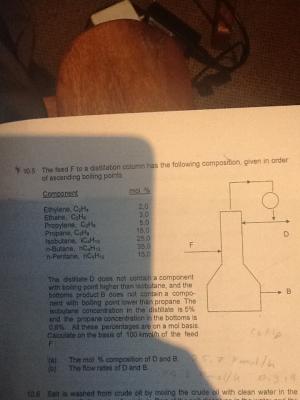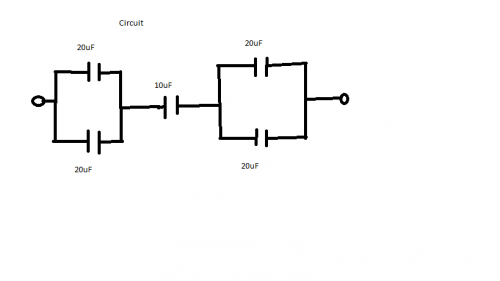-
Posts
75 -
Joined
-
Last visited
Content Type
Profiles
Forums
Events
Everything posted by Axioms
-
Ooo that was a good way to look at it. I never noticed that you could compare the % like that. Thanks .
-
Yes that is true but the isobutane and propane splits into B and D. They give percentages of Isobutane in B (its mol % in B not F) and propane in D. Then the mols in the other two streams will be unknown so we can call them x and y. A total mol balance: F = B + D Therefore 100 mol= B + D Mol balance of isobutane and propane: 25mol iC4H10 = 0.05(D) + xB and 15mol C3H8= yD + 0.008B (where y is unknown mol of propane and x is unknown mol of isobutane) My answer at a point that I cannot solve: 100= (15-y)(39.2-100x/(0.042+y-x))/0.008 + (39.2-100x/(0.042+y-x)). (F = B + D, I solved for B and D and subbed into F = D + B)
-
I'll post my working for the previous question later if that will help. I do have another question that I am struggling with. They give me a table with water density at certain temperatures: Where the density of water at 20C is 0.9988kg/L The question is: The SG of ethyl alcohol at 20C is 0.7893. What is the density of ethyl alcohol at 20C in lb/ft^3. Ok so this is what I did. 0.7893(kg/m^3 ethyl)/(kg/m^3 water) * (0.9982kg/L water) * (1000L/m^3) * ((0.3048m/ft)^3) * (lb/0.4536kg) = 49.18 lb/ft^3 It is apparently wrong. The way the question is phrased is that the SG is at 20C (and not just the ethyl), I took into account the density change of the water. The answer is 49.3lb/ft^3 but they take the density of water to be 1kg/L (I think because I worked it out with that density and it gave me an answer of 49.27lb/ft^3). Anyone have an explination as to why they use the one density over the other? Or does anyone think that the question is phrased incorrectely? My only thought: the SG is already corrected so that you can just multiply by 1kg/L water to find the density of the ethyl alcohol. If so, can anyone explain why? Any information would be appreciated.
-
I am busy studying for an exam and I am stuck on a particular question. I am not sure how to relate the flow rates to each other without getting more than one variable in the final equation. When I get one variable it solves incorrectely because you using four equations that become dependent when you relate more than two variables. Picture is down below. I may be over complicating something but I am stumped at this point in time. Any help would be much appreciated.
-
I did. I said thanks. It is simpler just to solve by hand but thanks anyway. I'm not sure if it would work because I'm shifting between a time domain and a phase domain constantly. Some of the numbers would be in a different domain and out of phase. I used a simple example to see if anyone knew if the matrix could be calculated on the calculator. I'd have then tried to apply the logic to my problem to see if it would be simpler than just working out what is needed. Thanks.
-
I know how to input complex numbers. I am just unsure if it is possible to input complex numbers in a matrix for the calculator to solve. I have lost my manual so thanks. I don't think it is possible because it cannot even solve for a variable if there are complex numbers in the equation. I guess I'm just hoping that there is a function on the calculator that I have not heard of before that can solve many equations of complex numbers simutaneously.
-
Hey I just want to find out if anyone knows if it is possible to enter complex numbers into a matrix of a scientific calculator. I have a CASIO fx-991ES PLUS scientific calculator. For example: If 20cos(200t -45)= 70jI1 + 90jI2 .....1 and 0=2jI1 +8jI2 ....... 2 Is there any way to solve these equations in a 2x2 matrix on a calculator? (The j's are imaginary, used so that there is no confusion with the variable vectors of I1 and I2). It is easy to solve these equations by hand but when it gets up to 4 equations to solve it gets far more tricky and time consuming. I am getting fed up with all the math that is involved to solve simple circuits, so I thought I'd come here and see if anyone has any advise. I have tried every possible method in trying to put the complex numbers into the calculator but it just keeps changing it back to real numbers and ignoring the imaginary numbers. Any help would be appreciated.
-
I did do voltage division and I got the right answer but I'm not sure if the logic is right. This is what I did to try and solve the breakdown voltage. I took the 10uF capacitor and applied 15V . I did voltage division with the equivalent circuit to find out the maximum voltage that the circuit can handle. Calculation: (10uF)/(20/3uF)*15 = 22.5V Thus you can apply a maximum voltage of 22.5V to the circuit before the 10uF capacitor will break.
-
Each capacitor in the combination shown has a breakdown voltage of 15V. What is the breakdown voltage of the combination? ...........20uF................................................20uF ----------/-------- ........10uF............------------/------------ A..........................--------/--------- .................................----------B ---------/---------.........................-----------/------------- .........20uF...........................................20uF Sorry this is the best I could do for the circuit diagram. It is capacitors between two points A and B. Full stops are there to keep the values in place they have no other meaning. The dashes represent the wire of the circuit. I calculated Ceq to be 20/3uF 1/Ceq = 1/(20+20) + 1/(10)+ 1/(20 + 20) so Ceq = 20/3uF There is no more information in the question and I am not sure how to calculate the breakdown voltage of the combination. I think I recall something that delt with the distance and voltage being to close and high respectively. I am sure it is a simple solution but I have no idea how to calculate it. Any help would be appreciated. Here is a better representation of the circuit
-
Did you find the ratio between AP and PB? You can then get a total length for AB. Do the same on the other side and you can then apply the cos rule.
-
The left side of the circuit is close to zero because there is hardly any change in potential difference (The resistance in the wires is really small). V=RI is the equation that defines how to work out a voltage in a simple circuit. Lets try work out what voltage is at the node on the left. V = (0 Ohm)(What ever the current is in the circuit). From this you can see you have to have a component in the circuit that will cause the potential drop. Lets work out the voltage at the first resistor. V1=RI = (resistance of R1)(current in the circuit) [current will be the same through both resistors because the circuit is in series]. As you see in your first diagram the voltage across the first resistor and the second resistor added together is equal to the total of the circuit. You can see that because of the resistance to the flow of charge, there must be a difference in the amount of potential given to the system. Think of it like this: you are pushing a block across a very slippery floor (the wire). You hardly have to push the block. You reach a patch that is really rough ground. You now have to push the block much harder to get it over this patch of ground (the resistor is the patch of ground and you having to push much harder is the voltage drop across the resistor). You get passed this patch of ground now and you are back on the slippery floor where you encounter hardly any effort to move the block.
-
3xyz= x^2 + y^2 + z^2 Solve for partial dz/dx and partial dz/dy. How do you get z as a term by itself? What is the right form of the equation to do the partial deriv.? Must you use implicit differentiation?
-
A poundal is lbmft/s^2 right? Is it possible to convert 800kg/m^3 into poundals? I can't find a way to get the time for poundals from kg/m^3.
-
It will do, in my opinion anyways.
-
I am trying to convert British Units into SI units for a heat transfer coefficient. My worry is the time in the british units (BTU/hft^2 -F-). The SI unit for heat of transfer does not have any time in it (W/m^2k). I tried converting W into Nm and then N into Kgm/s^2 and we are left with (Kg/s^2 -k-) but this does not relate to BTU in British units. If someone can show me how to get time into the SI units or tell me that it is not relevant I would appreciate it.
-
If we could do that then yes maybe. It would still depend on how much it would cost to keep generating it. Somebody always profits from war. Disease can get expensive if it is in a country that cares for its people and has enough funds to do so. Famine and disease usually go together though. All much cheaper than building a load of buildings.
-
I'm sure as our technology gets better it could be better used. I dont think we can use the ocean as a viable energy source at the moment. We havn't dreamt up the technology yet . We should concentrate on other much more viable renewable energy technologies. Energy sources that would actually be able to sustain our power consumption.
-
Yes, and we have war and disease. Edit: Sorry I was thinking in terms of accommodation though.
-
What exactly are you trying to cool down? It could work for inside the PC I would think. I dont think the temperatures will differ that much though. I think a fan blowing would be just as effective. Try drawing a diagram with brief instructions on it? It would be easier to picture what you trying to do.
-
A city that can fly. Fun. It would probably be cheaper to build 5000 skyscrapers over 500m high which would be easier to manage. Lets go with our imaginations here though. You would need to define an area that you want to lift into the air. Let us go with 5km^2 + how ever much foundation we need. When that is decided how would you get supplies up to the city when it is in flight? Will everyone in the city have a job? Or will it be for the wealthy only? Setting social and economic problems aside, how will the city be lifted into the air? If it doesnt crumble, I dont think it would be structually sound, what amount of energy would be required to keep it there? So many little factors that just seem to make the idea far to impractical. I liked the city in orbit idea. That could be constructed in space. Still economic and job problems there? Who would live there and how do they get supplies? Note: I would think that the start of the second paragraph is still much cheaper than anything else to deal with the over population.
-
From what I can see from that video is that he has an electromagnet over a tray of ferrofluid. I would make it like this: Place a tray of ferrofluid under an electromagnet. You can attach the electromagnet to a pully system, or any system that you can think of that will enable the electromagnet to move up and down, and it should work. You can even make the pully system out of wood and string. It doesn't need to be as elaborate as the video? If you use wood you could nail it into the wood? It does need to be an electromagnet though or you will struggle to get the liquid off the magnet. You could actually just hold the magnet over the liquid and it should do the same thing. Try to magnitise a smooth surface as well. You could get fancy and use a perm magnet that is brought into contact with a smooth highly magnetic metal which then can move down towards the tray of liquid. You then take the magnet off when you want the liquid to fall back down. I'm sure you will come right with a bit of ingenuity. Making the electronic moving parts would be much more tricky.
-
The second set of integrals would require a bit more than integration by parts. Look up integration methods on youtube. There should be something there that can help you. Try find something that can help you simplify the main equation and look for something that has an arctan (tan ^-1) for the last equation.
-

Looking for thoughts and opions: Violence and Video Games
Axioms replied to Asphyxia's topic in Homework Help
If the child is not mature enough to play the game I would think it could negatively affect the child. This is why there are age restrictions on every single game. Games in, my experience, have influenced my little brothers as they try to portray their favorite characters. I think it is a good thing because they add imagination to what they have been playing. They may seem to be more violent but weren't most childhood games, before computer games came about, violent? Cops and robbers, Cowboys and indians etc. My little brothers play a lot of games and it definatly has improved their critical thinking. It also has allowed them to socialise more easily. They are able to talk to their friends about the games and it forms a basis for friendship. I am also an avid gamer and the more challenging the game the more fun it is. There are not many games that do not have violence or some form law breaking that gamers would enjoy. I do agree that a 10 year old should not play an 18+ game. I don't think they would understand how to play the game in any case and would quickly get bored of it. This is my input from personal experience and many may disagree.



